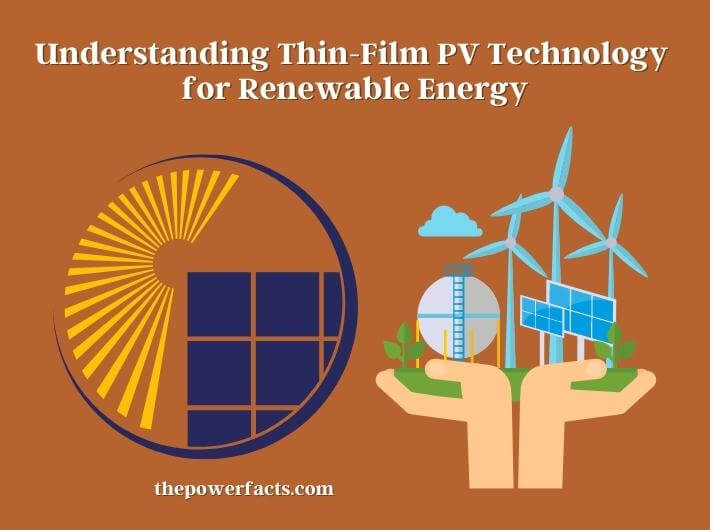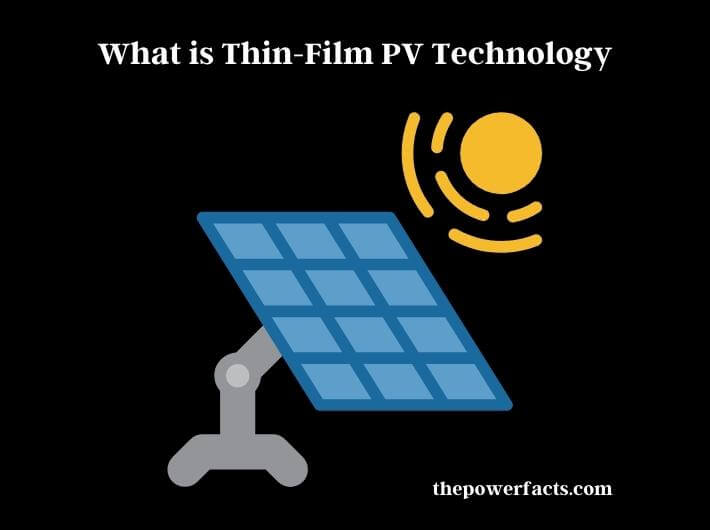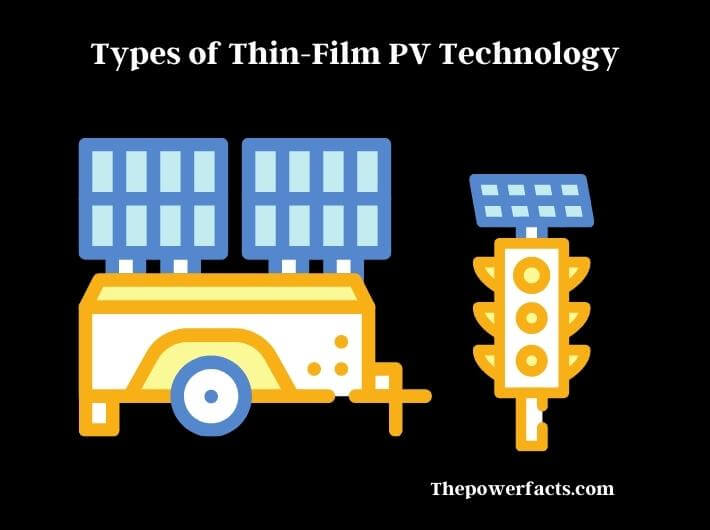Renewable energy has become a key focus in the fight against climate change and the transition to a more sustainable future. One of the most promising technologies in this area is thin-film photovoltaic (PV) technology. Thin-film PV cells are an innovative type of solar cell that is made by depositing one or more thin layers of semiconductor material onto a substrate, such as glass or plastic.

Compared to conventional silicon PV technology, thin-film PV technology offers several advantages, including lower cost, lightweight, and flexibility. These advantages have made it a popular choice for a wide range of applications, from building-integrated photovoltaics to large-scale solar projects.
We will explore the world of thin-film PV technology and how it works. We will discuss the different types of thin-film PV technology and their advantages and disadvantages, as well as their applications in various industries. We will compare thin-film PV technology to conventional silicon technology and explore the future of this promising innovation in the world of renewable energy.
What is Thin-Film PV Technology?
Thin-film PV technology is a type of solar cell that is made by depositing one or more thin layers of semiconductor material, such as cadmium telluride (CdTe), copper indium gallium selenide (CIGS), or amorphous silicon (a-Si), onto a substrate, such as glass or plastic.

Compared to conventional silicon PV technology, thin-film PV technology offers several advantages. Firstly, it is relatively inexpensive to produce, as it uses less material and requires less energy during the manufacturing process. Secondly, thin-film PV cells are lightweight and flexible, which makes them ideal for a range of applications, including building-integrated photovoltaics and portable power.
There are several types of thin-film PV technology, each with its own advantages and disadvantages. CdTe technology is currently the most widely used, as it has the lowest manufacturing cost and highest efficiency among thin-film technologies. CIGS technology is also gaining popularity due to its high efficiency and flexibility. However, both CdTe and CIGS technology require rare or toxic materials, which can pose environmental and health risks if not handled properly.
Thin-film PV technology is a promising innovation in the world of renewable energy, offering several advantages over conventional silicon technology. It is important to consider the environmental and health impacts of the materials used in this technology, as well as its potential limitations in terms of efficiency and durability.
Types of Thin-Film PV Technology
There are several types of thin-film PV technology, each with its own unique advantages and disadvantages. Some of the most common types include cadmium telluride (CdTe), copper indium gallium selenide (CIGS), and amorphous silicon (a-Si).
Cadmium Telluride (CdTe) CdTe is currently the most widely used thin-film PV technology, accounting for approximately 80% of global thin-film PV production. It is a low-cost, high-efficiency technology that has been commercially available since the 1990s. CdTe cells are made by depositing a thin layer of CdTe onto a substrate, typically glass. This is then coated with a transparent conductive layer of indium tin oxide (ITO) and a metal electrode. CdTe cells have an efficiency of up to 22%, making them more efficient than some types of conventional silicon cells. However, CdTe cells contain cadmium, which is a toxic material that can pose environmental and health risks if not handled properly.

Copper Indium Gallium Selenide (CIGS) CIGS is another popular type of thin-film PV technology, known for its high efficiency and flexibility. CIGS cells are made by depositing a thin layer of copper, indium, gallium, and selenium onto a substrate, typically glass or flexible material such as plastic. CIGS cells have an efficiency of up to 23.3%, making them more efficient than CdTe cells. Additionally, CIGS cells can be made in a variety of colors, making them an attractive option for building-integrated photovoltaics. However, CIGS cells also require rare materials, such as indium and gallium, which can increase their cost.
Amorphous Silicon (a-Si) a-Si is the oldest type of thin-film PV technology, first introduced in the 1970s. It is made by depositing a thin layer of amorphous silicon onto a substrate, typically glass or plastic. a-Si cells are low-cost and can be made in a variety of colors. However, they have a lower efficiency than other types of thin-film PV technology, typically around 8-10%.
Other types of thin-film PV technology include organic photovoltaics (OPV), dye-sensitized solar cells (DSSC), and perovskite solar cells. OPV and DSSC cells are still in the research and development stage, while perovskite cells are a relatively new technology that has shown promise in terms of efficiency but is still being studied for their durability and stability over time.
Each type of thin-film PV technology has its own unique advantages and disadvantages, and choosing the right technology depends on the specific application and requirements.
Advantages of Thin-Film PV Technology
Thin-film PV technology offers several advantages over traditional crystalline silicon (c-Si) solar cells, which makes them an attractive option for renewable energy applications. Some of the advantages of thin-film PV technology include:
Lower Cost:
Thin-film PV cells can be produced using less material and at a lower cost than c-Si cells. This is because they require less silicon and can be manufactured using simpler and less expensive production processes.
High Efficiency:
Thin-film PV cells have the potential to achieve high conversion efficiencies. Some types of thin-film PV cells, such as CdTe and CIGS, can achieve efficiencies that are comparable to c-Si cells, while others, such as perovskite cells, have demonstrated efficiencies of over 25%.
Flexibility:
Thin-film PV cells can be made on a variety of substrates, including flexible materials such as plastic. This allows them to be integrated into a wider range of products and applications, such as building-integrated photovoltaics, wearable devices, and transportation.
Better Performance in Low Light:
Thin-film PV cells can generate electricity in lower light conditions than c-Si cells. This makes them better suited for locations with less sunlight, such as regions with cloudy weather or indoor applications.
Reduced Environmental Impact:
Thin-film PV cells require less energy to manufacture than c-Si cells, and some types of thin-film PV cells, such as CdTe and CIGS, have a lower carbon footprint than c-Si cells. Additionally, thin-film PV cells do not require as much water in their production as c-Si cells, which can be an advantage in water-scarce regions.
Scalability:
Thin-film PV technology can be scaled up quickly and easily, which makes it well-suited for large-scale solar projects. This means that thin-film PV technology has the potential to make a significant contribution to meeting global energy demands.
The advantages of thin-film PV technology make it an attractive option for a variety of renewable energy applications. While they do have some limitations and challenges, such as lower durability and stability over time, ongoing research and development efforts are addressing these issues and improving the performance and reliability of thin-film PV cells.
Disadvantages of Thin-Film PV Technology
While thin-film PV technology offers several advantages, there are also some disadvantages to consider. Some of the main disadvantages of thin-film PV technology include:
Lower Durability:
Thin-film PV cells are generally less durable and stable over time than c-Si cells. This means that they may degrade faster and have a shorter lifespan, which can impact their long-term economic viability.
Lower Efficiency:
While some types of thin-film PV cells can achieve high conversion efficiencies, others have lower efficiencies than c-Si cells. This means that more thin-film PV cells may be required to generate the same amount of electricity, which can impact their cost-effectiveness.
Sensitivity to Temperature and Light:
Thin-film PV cells can be more sensitive to temperature and light conditions than c-Si cells. This means that their performance may be affected by changes in the environment, such as high temperatures or shading.
Limited Availability:
Some of the materials used to make thin-film PV cells, such as cadmium and tellurium, are rare and may become increasingly difficult to obtain in the future. This could impact the scalability and widespread adoption of thin-film PV technology.
Manufacturing Challenges:
While thin-film PV cells can be produced using simpler and less expensive manufacturing processes than c-Si cells, there are still some manufacturing challenges that need to be addressed. For example, the deposition process used to create thin-film PV cells can be complex and may require specialized equipment and expertise.
Environmental Concerns:
While thin-film PV cells can have a lower environmental impact than c-Si cells in some ways, they can also raise environmental concerns. For example, some types of thin-film PV cells, such as CdTe cells, contain toxic materials that require careful handling and disposal.
The disadvantages of thin-film PV technology need to be carefully considered and weighed against the advantages when making decisions about renewable energy investments. Ongoing research and development efforts are focused on addressing these challenges and improving the performance and reliability of thin-film PV cells.
Applications of Thin-Film PV Technology
Thin-film PV technology has a wide range of applications across various sectors. Here are some of the most common applications of thin-film PV technology:
Building Integrated Photovoltaics (BIPV): Thin-film PV modules can be integrated directly into building materials, such as windows, roofs, and facades, to provide clean and renewable energy.
Portable Electronic Devices: Thin-film PV cells are used in a variety of portable electronic devices, such as calculators, watches, and mobile phones, to provide a renewable power source for charging.
Off-Grid Power Systems: Thin-film PV technology can be used to power off-grid systems in remote areas, such as telecommunications towers, weather stations, and monitoring stations.
Transportation: Thin-film PV technology can be integrated into vehicles, such as cars, buses, and trains, to provide a source of renewable energy for powering onboard systems and reducing fuel consumption.
Large-Scale Solar Power Plants: Thin-film PV technology can be used to build large-scale solar power plants that generate electricity for the grid. Thin-film PV modules can be deployed on a variety of surfaces, including rooftops, ground-mounted arrays, and even floating platforms.
Consumer Products: Thin-film PV technology is used in a variety of consumer products, such as solar-powered backpacks, portable chargers, and outdoor lighting.
Agricultural Applications: Thin-film PV technology can be used in agricultural applications, such as powering irrigation systems and livestock water pumps in remote areas.
The versatility and flexibility of thin-film PV technology make it a promising option for a wide range of applications, from portable electronics to large-scale solar power plants. As technology continues to evolve and improve, it is expected to play an increasingly important role in the transition to a more sustainable and renewable energy future.
Final Thoughts
Thin-film PV technology is a promising and rapidly-evolving field that holds great potential for the future of renewable energy. Compared to traditional silicon-based PV technology, thin-film PV technology offers a number of advantages, including lower costs, greater flexibility, and higher efficiency in certain applications. However, it also has some disadvantages, such as lower overall efficiency and shorter lifespan.
Despite these challenges, the versatility and potential applications of thin-film PV technology make it an important area of research and development in the quest for a more sustainable and renewable energy future. From building-integrated photovoltaics and off-grid power systems to large-scale solar power plants and consumer products, thin-film PV technology has the potential to play a key role in meeting our energy needs while reducing our reliance on fossil fuels.
As researchers continue to innovate and improve thin-film PV technology, it will be important to balance the advantages and disadvantages of the technology in order to ensure its widespread adoption and long-term viability. With continued investment and development, thin-film PV technology has the potential to transform the way we generate and use energy, paving the way for a cleaner, more sustainable future.
If you want to know How You Need to Charge Your RV Battery With Solar? Here is the reply.